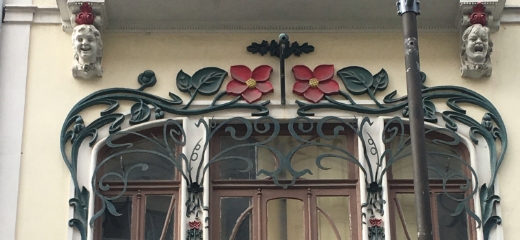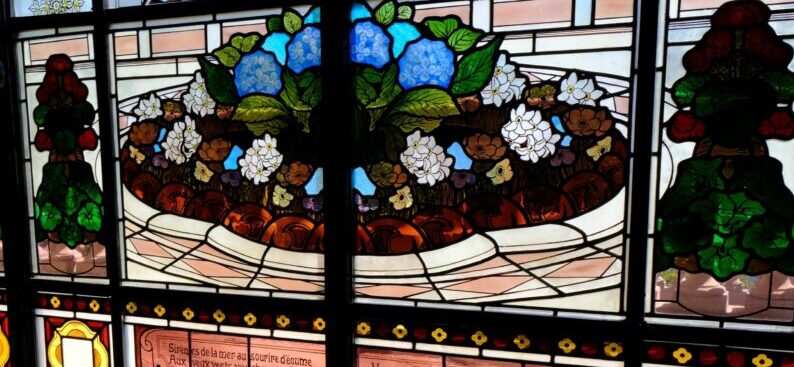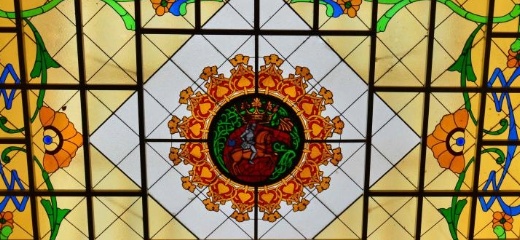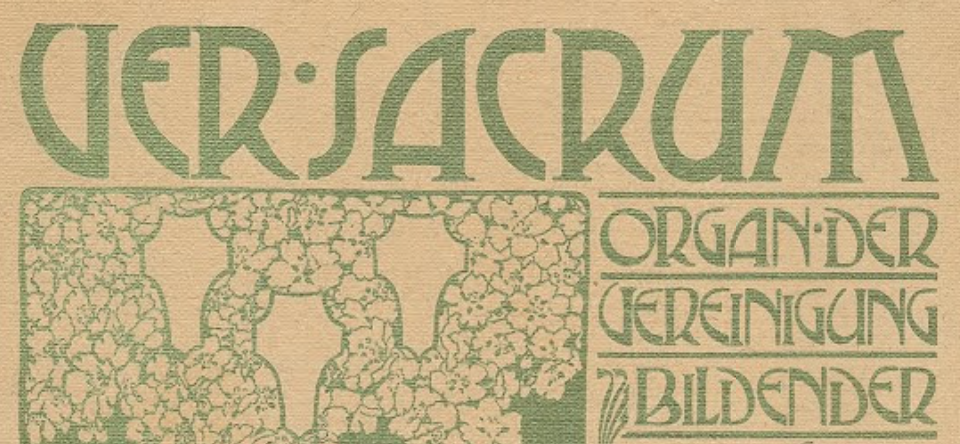The role of botany and zoology in Art Nouveau design is a fascinating topic, as the natural world played a significant role in inspiring Art Nouveau artists. Plants, flowers, and trees were particularly popular motifs in Art Nouveau art and design, and were often stylized and abstracted to create intricate, decorative patterns. Some of the most commonly used botanical motifs in Art Nouveau include:
- The iris was a popular motif in Art Nouveau, particularly in the work of artists such as Émile Gallé and René Lalique. The iris was often depicted in a stylized, abstracted form, with long, curving stems and delicate, pointed petals. The iris symbolized elegance, purity, and grace, and was often used in Art Nouveau designs for perfume bottles, vases, and other decorative objects.
- The lily was another popular botanical motif too. The stylized lily was often depicted in a long, flowing form, with curving stems and elongated petals. The lily symbolized purity, beauty, and innocence, and was often used in Art Nouveau designs for jewelry, furniture, and other decorative objects.
- The oak tree is particularly seen in the work of architects such as Antoni Gaudí and Hector Guimard. The oak tree symbolized strength, endurance, and stability, and was often used in Art Nouveau designs for doorways, windows, and other architectural features.
In addition to botanical motifs, Art Nouveau artists also drew inspiration from the animal world. Some of the most commonly used zoological motifs in Art Nouveau art and design include:
- The peacock was a popular motif in Art Nouveau, particularly in the work of artists such as Alphonse Mucha and Gustav Klimt. The peacock symbolized beauty, elegance, and pride, and was often depicted in a stylized, abstracted form with long, flowing feathers and intricate patterns.
- The dragonfly was another popular zoological motif in Art Nouveau art and design. The dragonfly symbolized transformation, change, and freedom, and was often depicted in a stylized, abstracted form with long, delicate wings and intricate patterns.
By incorporating these and other natural motifs into their designs, Art Nouveau artists created a style that was both beautiful and meaningful, and that continues to captivate audiences today. The use of organic forms in Art Nouveau architecture, characterized by its flowing, organic forms, which were inspired by the natural world. Architects of the Art Nouveau movement sought to break away from the rigid, symmetrical designs of the past, and instead embraced asymmetry, undulating curves, and irregular forms that mimicked the shapes of leaves, flowers, and other organic materials.
-
- One of the most famous examples of Art Nouveau architecture is the Casa Batlló, a residential building located in Barcelona, Spain. Designed by Antoni Gaudí, Casa Batlló features a façade that resembles the scales of a dragon or a fish, with undulating lines and organic forms that mimic the curves of sea creatures. The building is covered in a colorful mosaic of tiles, creating a shimmering effect that changes throughout the day as the light hits it from different angles.
- Another notable example of Art Nouveau architecture is the Hôtel Tassel, a townhouse located in Brussels, Belgium. Designed by Victor Horta, the Hôtel Tassel features a façade that is covered in ornate wrought iron, with a curving staircase that seems to float in mid-air. The interior of the building is equally impressive, with a stunning glass ceiling that floods the space with natural light, and a variety of intricate details that showcase the designer\’s mastery of organic forms.
- In Paris, France, the Métro entrances designed by Hector Guimard are some of the most recognizable examples of Art Nouveau architecture. The entrances are made of cast iron, with undulating curves and flowing lines that resemble the tendrils of a plant or the waves of the sea. The use of cast iron allowed for intricate details to be incorporated into the design, such as floral motifs and swirling vines.
Art Nouveau architecture can be found all over the world, from the intricate tilework of the Park Güell in Barcelona, to the ornate facades of the Riga Art Nouveau district in Latvia. These buildings showcase the versatility and beauty of organic forms in architecture, and continue to inspire architects and designers today.
Many Art Nouveau artists were inspired by the Arts and Crafts movement, which emphasized traditional craftsmanship and a return to nature. This can be seen in many forms and materials.
Whether you are admiring the graceful lines of an Otto Wagner building or exploring the lush gardens of an Art Nouveau park, you will be captivated by the natural beauty and intricate details of Art Nouveau. So why not plan your next travel adventure to an Art Nouveau city, and immerse yourself in the beauty and charm of this unforgettable artistic movement? check our top 6 destinations of all times HERE.
Visit artnouveau.club to stay updated on Art Nouveau news and experiences around the globe. If you have an event or information to contribute, email us at contact@artnouveau.club.






